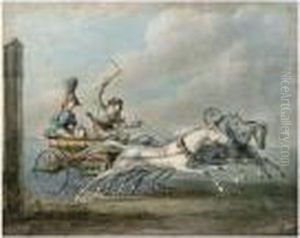Alexandre Ivanovitch Sauerweid Paintings
Alexandre Ivanovitch Sauerweid was a prominent Russian painter, best known for his remarkable contributions to military art and his vivid portrayal of battles and historical scenes. Born in 1783 in Mitau (now Jelgava, Latvia), which was then part of the Duchy of Courland and Semigallia (a vassal state of the Polish-Lithuanian Commonwealth), Sauerweid's artistic talents emerged at an early age. His early education and artistic training remain somewhat obscure, but it is known that he moved to Russia to further his career, becoming deeply integrated into Russian cultural and artistic circles.
Sauerweid's work gained significant attention in the early 19th century, a period marked by the Napoleonic Wars, which provided ample material for his military scenes. He was particularly adept at capturing the dynamism and chaos of battle, focusing on both the grandeur of military maneuvers and the individual valor of soldiers. His attention to detail, not only in the depiction of military uniforms and equipment but also in the landscapes and settings of his battles, earned him a place as a court painter to Tsar Alexander I of Russia. This prestigious position allowed him to work closely with the military and to attend significant battles, enabling him to produce works with a high degree of accuracy and authenticity.
In 1819, Sauerweid was appointed as a professor at the Imperial Academy of Arts in Saint Petersburg, reflecting his esteemed status in the Russian art world. During his tenure, he influenced a generation of artists, imparting his meticulous approach to historical painting and his passion for military subjects. Despite his focus on military art, Sauerweid's oeuvre was not limited to this genre alone; he also produced a number of portraits and landscapes, demonstrating his versatility as an artist.
Sauerweid's legacy is marked by his contribution to the visual documentation of Russian military history, providing future generations with an artistic record of key historical events. His paintings remain a valuable resource for historians and art lovers alike, offering insight into the Napoleonic Wars and the broader European military conflicts of the early 19th century. Alexandre Ivanovitch Sauerweid passed away in 1844 in Saint Petersburg, leaving behind a body of work that continues to be celebrated for its historical significance and artistic merit.

